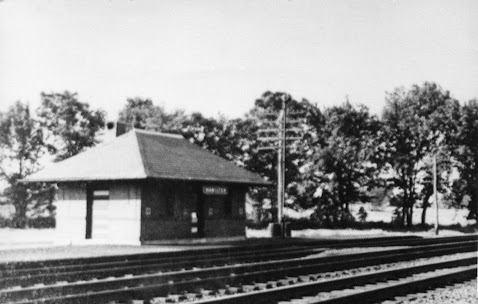The Delaware and Bound Brook Railroad - later a division of the Philadelphia and Reading and known in Central New Jersey today as the West Trenton Line - is one of the most important railroads in New Jersey history. It is also important to Hillsborough history - not only because 7 of its 27 miles of track were laid in Hillsborough but because of the connection to Hillsborough of two men intimately associated with the story.
 |
| Henry Martyn Hamilton and Peter Dumont Vroom |
Governor Peter Dumont Vroom was born in the village of South Branch in 1791. He attended grade school at the "Old Red Schoolhouse" (it was brand new then!) on River Road near Beekman Lane, and "high school" at the Somerville Academy. After graduating from Columbia and reading law in Somerville, he practiced in Sussex and Hunterdon Counties before moving back to Somerville in 1826 and being elected to the state legislature and then as governor in 1829.
 |
| 1870s Delaware and Bound Brook Railroad ticket, (collection of Gillette on Hillsborough) |
One of Vroom's most important acts as governor was to nurture the nascent railroad and canal business in New Jersey. He promoted granting charters to the Camden and Amboy Railroad and the Delaware and Raritan Canal which gave those companies exclusive rights to build interstate (i.e. New York to Philadelphia) transportation lines across the state - and then he endorsed the merger of the two companies as The United Companies, thus creating a virtual railroad monopoly enshrined in state law.
 |
| 1884 railroad map showing the stations of the Delaware and Bound Brook Railroad. Missing from the map is Weston Station which was just north of Hamilton. |
Henry Martyn Hamilton was born in Ohio in 1831. He attended college first in Ohio but a case of typhoid fever prevented him from graduating. After recovering he continued at Hamilton College in New York State where he also received his law degree. The enterprising young man then returned to the midwest and became one of the four founders of the town of Grinnell, Iowa. It was in this enterprise that he first became involved in the railroad business, trying to lure railroads to build lines through Grinnell and other midwest cities. He soon came to the New York area, making money as a financier and settling in Bloomfield.
 |
| Belle Mead Station circa 1905 (collection of Gillette on Hillsborough) |
 |
| The Delaware and Bound Brook Yardleyville Centennial Bridge 1876 |
 |
| The 1929 west Trenton Station, photographed circa 1961 |
 |
| Pennington Station |
 |
| Hopewell Station |
 |
| Stoutsburg, Skillman, and Harlingen Stations - top to bottom |
In the midst of all of this, Hamilton took a meeting with a "former State Governor" and a representative of the United Companies. An offer of a half-million dollars upfront and a $5,000 no-show job was made to entice Hamilton to walk away, but as he told confidantes, "I can afford to be defeated, but I can't afford to sell out my friends."
 |
| Royal Blue Line postcard (collection of Gillette on Hillsborough) |
Hamilton began building immediately in an effort to have the railroad open in time for the Philadelphia Centennial Exposition in 1876. The line had been surveyed through Mercer and Somerset Counties to "a point near the village of Millstone". That spot was in the vicinity of today's Hamilton and North Willow Roads - which is where Hamilton moved with his family and built a station.
 |
| Ad for the Royal Blue Line - an upscale passenger service between New York and Washington |
 |
| Hamilton Station on North Willow Road in Hillsborough |
 |
| Hillsborough's Weston Station circa 1905 |
The new Jersey portion of the line crossed the Delaware at the Yardleyville Centennial Bridge (replaced in 1912) and had station stops at Ewing, Pennington, Moore's, Hopewell, and Stoutsburg in Mercer County. The twin stations at Pennington and Hopewell are still standing.
 |
| The Reading "Crusader" - a streamlined speedster - near Weston Station |
In Somerset County, the stations were at Skillman, Harlingen, Belle Mead (originally called Van Aken), Hamilton, Weston, and Bound Brook. The new stations built at Belle Mead in 1919 and Bound Brook in 1913 are the only ones that survive.
 |
| The 1875 Philadelphia and Reading railroad bridge crossing the Raritan River (collection of Gillette on Hillsborough) |
The Delaware and Bound Brook Railroad opened on May 1, 1876 - about three years after the death of Governor Vroom. In 1879 it was leased to the Philadelphia and Reading Railroad. Hamilton attempted to build a namesake city at the location of Hamilton Station in Hillsborough. He laid out streets and tried to get investment, to no avail.
 |
| The 1913 Philadelphia and Reading Bound Brook Station |
No comments:
Post a Comment